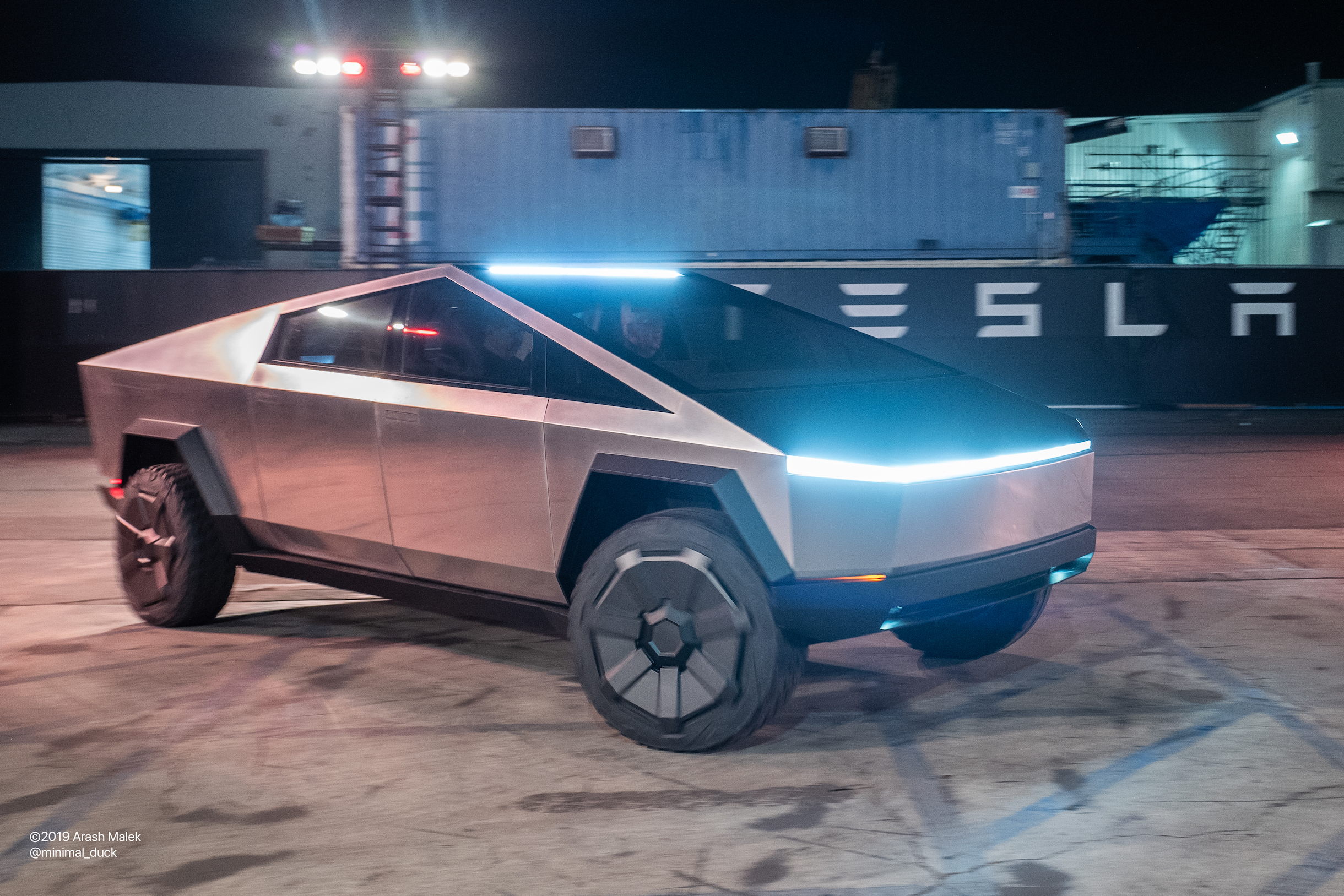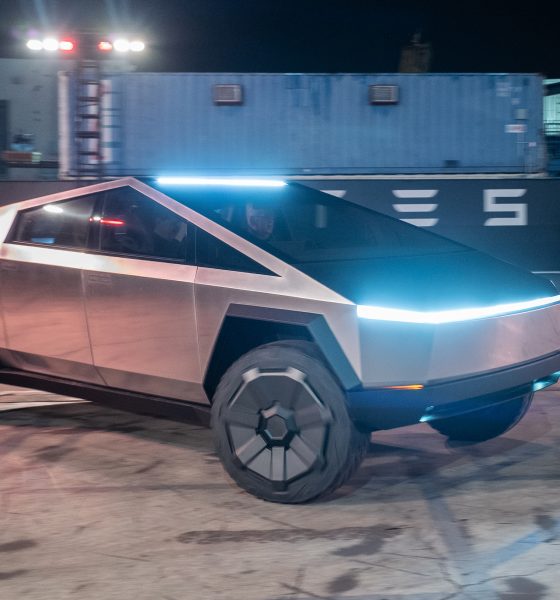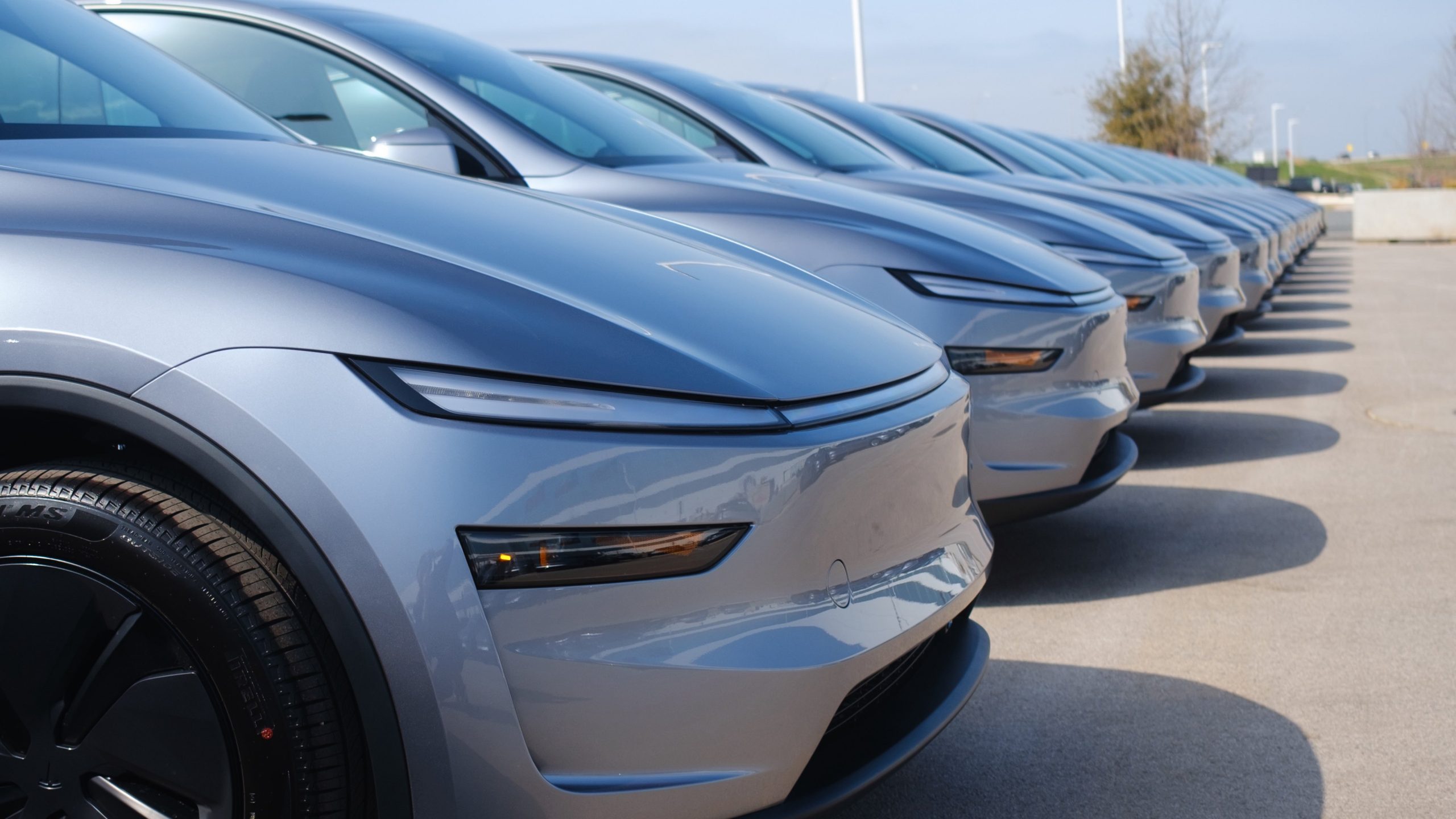

News
Tesla Cybertruck will have “laser blade lights” and adjusted dimensions
Tesla Cybertruck’s width will be roughly 82 inches and the vehicle will come standard with upper “laser blade lights”, according to the most recent update provided by CEO Elon Musk.
Musk clarified via Twitter that the previously announced width of the upcoming all-electric truck might be too small. The Cybetruck officially measured 84 inches wide when it was unveiled in Los Angeles last November 2019, but he estimated a possible reconfiguration to around 80 inches wide to make the Cybertruck fit in typical garage setups.
The Tesla Cybertruck will also feature upper laser blade lights, the aesthetically futuristic bar of lights across the top of the truck’s windshield. While details about this feature are very limited, the laser blade lights are said to help provide the driver with better visibility, especially needed in challenging terrain or dark outback excursions. Additionally, the laser blade lights add a cool factor to the dystopian vehicle that has reportedly caught the interest of over 500,000 reservation holders since its debut.
Btw, in some prior tweets I’d said production Cybertruck would be ~80” wide (vs ~84” body width at unveil). This is slightly too small. Will be closer to 82”, but come standard with upper laser blade lights.
— Elon Musk (@elonmusk) February 21, 2020
Elon Musk was pretty generous with Tesla Cybertruck updates Friday night. When asked if the much-awaited pickup truck’s look will generally be the same, he said that “it’s slightly better.”
This latest Cybertruck news from Musk also shows how Tesla listens to the electric vehicle community just like when Musk confirmed that owners will be able to comfortably camp in the Cybertruck’s truck bed and that it would come with a flip stop for those hauling long cargo.
Unclear is how Tesla’s electric pickup might fit in a typical residential garage in the United States. In response to Teslarati’s story on how one Youtuber used a to-scale Cybertruck AR mobile app to discover that the truck’s dimensions were too big for a home garage, Musk responded with his thoughts on how Cybertruck’s length and width can be adjusted.
We can prob reduce width by an inch & maybe reduce length by 6+ inches without losing on utility or esthetics. Min height is below 75 inches when air suspension set to low. Will post exact number soon.
— Elon Musk (@elonmusk) December 7, 2019
Typical two-car garages in the United States measure around 20×20, 22×22, or 24×24 feet. While these measurements are fine for the usual sedans and SUVs like the Model S, Model X and Model 3, or crossovers such as the Model Y, things can get a bit tight for mid-size utility pickups like the Tesla Cybertruck that originally measured 231.7 inches long, 84 inches wide, and 75 inches high. The parking issue is not unique to the Cybertruck as owners of Ford F-150 Supercrew and Dodge RAM pickups have reported that their trucks are often too long to fit inside their garages. With the adjusted width, the Cybertruck will fit in the same external envelope as full-size SUVs just like how Elon Musk pictures it.
The Cybertruck’s Tri-Motor and Dual Motor versions are expected to hit the production line in 2021.
Tesla Cybertruck Dimensions
- Width: 82″ (2083 mm)
- Height: 75″ (1905 mm)
- Length: 225″ to 231″ (5715 mm to 5892 mm)
- Wheelbase: 149.9″ (3807 mm)

News
Tesla partners with Lemonade for new insurance program
Tesla recently was offered “almost free” coverage for Full Self-Driving by Lemonade’s Shai Wininger, President and Co-founder, who said it would be “happy to explore insuring Tesla FSD miles for (almost) free.”

Tesla owners in California, Oregon, and Arizona can now use Lemonade Insurance, the firm that recently said it could cover Full Self-Driving miles for “almost free.”
Lemonade, which offered the new service through its app, has three distinct advantages, it says:
- Direct Connection for no telematics device needed
- Better customer service
- Smarter pricing
The company is known for offering unique, fee-based insurance rates through AI, and instead of keeping unclaimed premiums, it offers coverage through a flat free upfront. The leftover funds are donated to charities by its policyholders.
On Thursday, it announced that cars in three states would be able to be connected directly to the car through its smartphone app, enabling easier access to insurance factors through telematics:
Lemonade customers who own @Tesla vehicles in California, Oregon, and Arizona can now connect their cars directly to the Lemonade app! ⚡🚘
Direct connection = no telematics device needed 📵
Better customer experience 💃
Smarter pricing with Lemonade 🧠This is a game-changer… pic.twitter.com/jbabxZWT4t
— Lemonade (@Lemonade_Inc) December 11, 2025
Tesla recently was offered “almost free” coverage for Full Self-Driving by Lemonade’s Shai Wininger, President and Co-founder, who said it would be “happy to explore insuring Tesla FSD miles for (almost) free.”
The strategy would be one of the most unique, as it would provide Tesla drivers with stable, accurate, and consistent insurance rates, while also incentivizing owners to utilize Full Self-Driving for their travel miles.
Tesla Full Self-Driving gets an offer to be insured for ‘almost free’
This would make FSD more cost-effective for owners and contribute to the company’s data collection efforts.
Data also backs Tesla Full Self-Driving’s advantages as a safety net for drivers. Recent figures indicate it was nine times less likely to be in an accident compared to the national average, registering an accident every 6.36 million miles. The NHTSA says a crash occurs approximately every 702,000 miles.
Tesla also offers its own in-house insurance program, which is currently offered in twelve states so far. The company is attempting to enter more areas of the U.S., with recent filings indicating the company wants to enter Florida and offer insurance to drivers in that state.
News
Tesla Model Y gets hefty discounts and more in final sales push

Tesla Model Y configurations are getting hefty discounts and more benefits as the company is in the phase of its final sales push for the year.
Tesla is offering up to $1,500 off new Model Y Standard trims that are available in inventory in the United States. Additionally, Tesla is giving up to $2,000 off the Premium trims of the Model Y. There is also one free upgrade included, such as a paint color or interior color, at no additional charge.
NEWS: Tesla is now offering discounts of up to $1,500 off new Model Y Standard vehicles in U.S. inventory. Discounts of up to $2,000 are also being offered on Model Y Premiums.
These discounts are in addition to the one free upgrade you get (such as Diamond Black paint) on… pic.twitter.com/L0RMtjmtK0
— Sawyer Merritt (@SawyerMerritt) December 10, 2025
Tesla is hoping to bolster a relatively strong performance through the first three quarters of the year, with over 1.2 million cars delivered through the first three quarters.
This is about four percent under what the company reported through the same time period last year, as it was about 75,000 vehicles ahead in 2024.
However, Q3 was the company’s best quarterly performance of all time, and it surged because of the loss of the $7,500 EV tax credit, which was eliminated in September. The imminent removal of the credit led to many buyers flocking to Tesla showrooms to take advantage of the discount, which led to a strong quarter for the company.
2024 was the first year in the 2020s when Tesla did not experience a year-over-year delivery growth, as it saw a 1 percent slide from 2023. The previous years saw huge growth, with the biggest coming from 2020 to 2021, when Tesla had an 87 percent delivery growth.
This year, it is expected to be a second consecutive slide, with a drop of potentially 8 percent, if it manages to deliver 1.65 million cars, which is where Grok projects the automaker to end up.
Tesla will likely return to its annual growth rate in the coming years, but the focus is becoming less about delivery figures and more about autonomy, a major contributor to the company’s valuation. As AI continues to become more refined, Tesla will apply these principles to its Full Self-Driving efforts, as well as the Optimus humanoid robot project.
Will Tesla thrive without the EV tax credit? Five reasons why they might
These discounts should help incentivize some buyers to pull the trigger on a vehicle before the year ends. It will also be interesting to see if the adjusted EV tax credit rules, which allowed deliveries to occur after the September 30 cutoff date, along with these discounts, will have a positive impact.
News
Tesla FSD’s newest model is coming, and it sounds like ‘the last big piece of the puzzle’
“There’s a model that’s an order of magnitude larger that will be deployed in January or February 2026.”

Tesla Full Self-Driving’s newest model is coming very soon, and from what it sounds like, it could be “the last big piece of the puzzle,” as CEO Elon Musk said in late November.
During the xAI Hackathon on Tuesday, Musk was available for a Q&A session, where he revealed some details about Robotaxi and Tesla’s plans for removing Robotaxi Safety Monitors, and some information on a future FSD model.
While he said Full Self-Driving’s unsupervised capability is “pretty much solved,” and confirmed it will remove Safety Monitors in the next three weeks, questions about the company’s ability to give this FSD version to current owners came to mind.
Musk said a new FSD model is coming in about a month or two that will be an order-of-magnitude larger and will include more reasoning and reinforcement learning.
He said:
“There’s a model that’s an order of magnitude larger that will be deployed in January or February 2026. We’re gonna add a lot of reasoning and RL (reinforcement learning). To get to serious scale, Tesla will probably need to build a giant chip fab. To have a few hundred gigawatts of AI chips per year, I don’t see that capability coming online fast enough, so we will probably have to build a fab.”
NEWS: Elon Musk says FSD Unsupervised is “pretty much solved at this point” and that @Tesla will be launching Robotaxis with no safety monitors in about 3 weeks in Austin, Texas. He also teased a new FSD model is coming in about 1-2 months.
“We’re just going through validation… https://t.co/Msne72cgMB pic.twitter.com/i3wfKX3Z0r
— Sawyer Merritt (@SawyerMerritt) December 10, 2025
It rings back to late November when Musk said that v14.3 “is where the last big piece of the puzzle finally lands.”
With the advancements made through Full Self-Driving v14 and v14.2, there seems to be a greater confidence in solving self-driving completely. Musk has also personally said that driver monitoring has been more relaxed, and looking at your phone won’t prompt as many alerts in the latest v14.2.1.
This is another indication that Tesla is getting closer to allowing people to take their eyes off the road completely.
Along with the Robotaxi program’s success, there is evidence that Tesla could be close to solving FSD. However, it is not perfect. We’ve had our own complaints with FSD, and although we feel it is the best ADAS on the market, it is not, in its current form, able to perform everything needed on roads.
But it is close.
That’s why there is some legitimate belief that Tesla could be releasing a version capable of no supervision in the coming months.
All we can say is, we’ll see.








